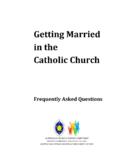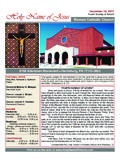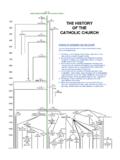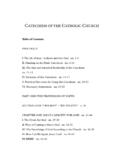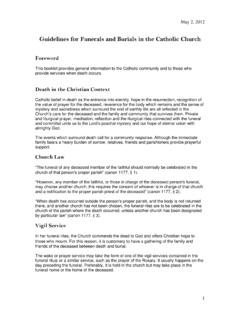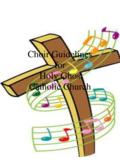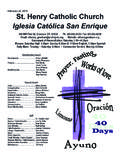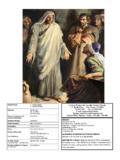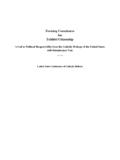Transcription of St. Leo Catholic Church Building Plan
1 St. Leo Catholic Church Building plan P a g e | 2 Contents Page Summary 3 Background 4 Murray, Kentucky 4 Renovation Needs 5 Capacity Needs 6 The plan 7 Project Cost 12 Project Funding 12 Request 13 P a g e | 3 Summary St. Leo is in the midst of a Building program to increase seating capacity and enable us to better minister to the spiritual development of the parish and larger community. Our current Church has a seating capacity of 300. It has no Gathering Space, no restrooms, and no Blessed Sacrament Chapel. It is not fully handicapped accessible and does not embrace our growing Hispanic community. Our plan calls for: Expanding the facility to accommodate 530 Adding a Gathering Space, restrooms, and a Blessed Sacrament Chapel Making all spaces fully handicapped accessible Modifying the exterior to better communicate that the Building is a place of worship Adding an Our Lady of Guadalupe devotional area to address the faith expressions of our growing Hispanic population Transforming the worship experience for all our parishioners and guests The projected cost to make these improvements is $ million.
2 With exceptional parish support for the Building plan , we intend to break ground mid-2010 and complete the project using a loan from the Diocese of Owensboro. We have relied on professionals for the architectural and liturgical design and fundraising. In addition, we have involved the entire parish throughout the development of this program to make it their project. As a result, we have an inspirational, yet efficient design and we enjoy tremendous support from our parishioners. P a g e | 4 Background St. Leo Catholic Church in Murray, Kentucky began in 1933 with the establishment of a Civilian Conservation Corps camp. With the camp came more Catholics, so a priest began traveling to Murray each weekend to say Mass under a pavilion.
3 With the help of a grant from the Catholic Church Extension Society and the hard work of the pastor and 150 parishioners, the first Catholic Church Building was completed in the fall of 1943. By 1963, the parish had outgrown the Building and proceeded to construct the current, 300 seat Church with a connected rectory. Shortly after that, a Newman campus ministry was started at nearby Murray State University, so the old Church was renovated and used for Newman House activities. Since then, the Newman House ministry has moved to a property across the street from St. Leo, the old Church was converted to parish offices, and a Parish Hall was constructed. Currently, the facilities include the Church , connected rectory, parish hall, parish offices, and the Newman House.
4 Today, St. Leo Parish is a vital, growing faith community with 420 registered families. It is the only Catholic Church in Murray, Kentucky, a largely Protestant community. Murray, Kentucky Murray, the county seat for Calloway County, is situated in southwest Kentucky. It is eight miles from the Tennessee state line, fifteen miles from Kentucky Lake and the Land Between the Lakes National Recreational Area, and 125 miles from Nashville. The population of Calloway County is 36,000 with 17,000 living in Murray. Over the years, Murray has become a top retirement area in the nation. The development of Kentucky Lake, Lake Barkley, the Land Between the Lakes Recreational Area, and the growth of Murray State University have all contributed to its growth.
5 In addition, as companies such as Briggs and Stratton, Ken Lake Foods, and Pella Corporation have located and grown in Murray, they have brought more Catholics into the area from the Midwest and North. These Catholic "immigrants" have brought with them a rich diversity of Catholic heritage that has added greatly to the parish and the community. We have also benefited from our growing Hispanic community who share with us a very old and sacred Catholic tradition. Murray is also home to Murray State University, a four-year public university with over 10,000 students. News & World Report rates Murray State as one of the nation's top public universities. St. Leo places a high priority on ministering to the many Catholic students at Murray State.
6 In fact, when considering whether to expand and renovate the current Church on our limited land or build a new Church on more land less central to town, St. Leo s walking distance to campus was a major deciding factor. P a g e | 5 Renovation Needs In February 2004, parish leaders held a full-day strategic planning event. One of the major conclusions from that event was that our growth and development were being hampered by our buildings and facilities. To ensure the problem was fully understood and that the parish at large agreed with this assessment, a parish survey was executed to get input from all parishioners. Parishioners were asked to rate every aspect of our current facilities for both how well the facilities meet our needs and how important the facilities are to meet the mission and vision of St.
7 Leo. As shown in Figure 1, the parish overwhelmingly reported that our current facility does not meet our needs, with most aspects of our facilities receiving a rating of less than 6 on a scale of 1 to 10. In addition, all of the facilities were rated as being of High or Very High importance. Figure 1: June, 2004 Parishioner Survey of Current Facilities 012345678910 Location in townInclusion of MSU Social spaceClassroomsComfortKitchenWorship spaceSeatingParking/sidewalksAudio visualSetting/groundsBaptismal fontCry RoomLightingD corChurch entranceRestroomsMusic spacePrayer ChapelGathering spaceAverage "Meets our needs" RatingImportanceVery High ( to )High ( to )Average Importance P a g e | 6 Capacity Needs Another consideration that emerged at the strategic planning event was seating capacity in the worship space.
8 We estimated future needs in three ways. First, the growth rate of the St. Leo community was projected to 10 and 25 years out. Second, estimates were made for the impact of a potential priest shortage, which would lead to fewer Masses in the region and more people attending each Mass. Third, consideration was given to the expected growth caused by the excitement created by a newer, larger facility. The results of this analysis are shown in Figure 2. As can be seen, normal organic growth will lead us to turn away people at our peak weekend Mass within ten years. The effects of a priest shortage and/or evangelization will cause us to exceed the capacity of the current structure much more quickly. P a g e | 7 The plan From the beginning, we sought to develop a plan that provides the capacity and functionality we need while fitting our keep-it-simple culture and our limited economic means.
9 To accomplish this, our Building and Liturgical Design Committees worked closely with an architect and a liturgical design consultant. After an exhaustive consideration of alternatives with regular input from the parish at large, we believe we have come up with the best possible design. The primary attributes of the expanded and renovated facility are shown in Table 1 below. Table 1: Current versus Planned Facility Current Planned 300 person Worship Space 530 person total capacity Worship Space No Gathering Space Formal Gathering Space with capacity for 216 No restrooms (have to go to the Rectory) Handicapped accessible men s and women s restrooms No Blessed Sacrament Chapel Dedicated Blessed Sacrament Chapel Baptismal Font is a glass bowl on wooden stand near Altar Built-in Baptismal Font at main entrance to Worship Space with full emersion option No flexible seating Flexible seating at front and rear of Church Steps at main entrance and Altar Entire facility is handicapped accessible, including Altar Uninviting main entrance long walk from parking, opens to busy street Inviting main entrance, close to parking with covered walkway and drop-off Plain, small oak Altar Larger, more inspirational Altar made of inlayed wood, black iron, and granite Plain exterior.
10 Not obvious it is a Catholic Church Commanding bell tower and exterior that communicate we are a proud Catholic community Interior of cinder block walls and small galvanized steel-framed windows Interior of smooth walls and slender, curved-top windows that let in 3 times the light Simple painting of Our lady of Guadalupe with no place for flowers Dedicated Our Lady of Guadalupe devotional area Renderings of the expanded and renovated facility as well as photos of our current Church are shown in Figures 3, 4, and 5 below. P a g e | 8 Figure 3a: Rendering of Expanded and Renovated St. Leo Looking Southwest Figure 3b: Photo of Current Church Looking Southwest Note that the views looking northwest and southwest are from Highway 641, which is the main road through Murray.
